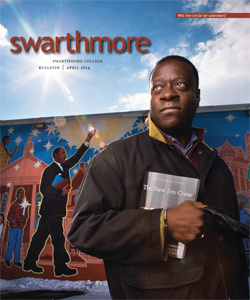Swarthmore 1965: A Creative and Close Community
Enthusiasm for the Creative Arts, the Honors Program, Civil Rights, New Committees …
They Have Diverse Interests—and Talk about Them
The overall impression is of a school that has made a definite commitment to its own idea of liberal arts education. There is certainly dialogue (to use a common Swarthmore word) about where Swarthmore should go from here, but today it knows what it stands for.
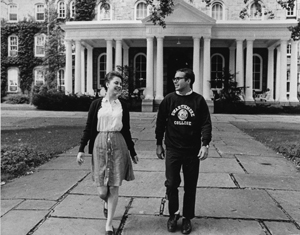
Photos courtesy of Friends Historical Library.
Swarthmore is a close community. “There’s no weekend exodus here,” said one boy. “People are working too hard.” It’s also difficult to get permission to use a car, granted only for cars to be used for student organizations. Although the train to Philadelphia leaves frequently from the edge of the campus (one-way $.69, round trip $.94), the only people who go into the city regularly are music buffs, who go to the symphony on Monday nights.
Weekend Programs
Dean of Men Robert Barr ’56 said that most contacts with other colleges in their four-college consortium (including Haverford, Bryn Mawr, and the University of Pennsylvania) are academic, not social. The well-endowed Cooper Foundation at Swarthmore is administered by a joint committee of students and faculty. Through it and other programs, “There is at least one concert or lecture on campus every weekend night—usually free," said Dick Scheinman ’66, editor of the Swarthmore Phoenix. The weekend we were there was typical: a Friday-night concert of contemporary chamber music, a Saturday-night movie (James Cagney and Dick Powell in a 1933 musical), and a Sunday night lecture on Yeats by Irish literary critic Denis Donoghue. All were free and well-attended.
Social life is relaxed and casual. Friendships are struck up in seminars, in the Arts Center of the Little Theater Club (LTC), or in Sharples Dining Hall, where the spacious and quiet surroundings are conducive to long dinner-table conversations. Impromptu parties are a popular diversion. At a weekday evening birthday party we attended, conversations grew spirited as friends drifted in. A few came as obvious couples, but most arrived in casual mixed groups of three or four.
Nobody Can Dance
The Beatles played in a corner of the lodge where the party was, but never more than two couples danced at one time all evening. “I’ll bet there’s more dancing than this at Amherst,” admitted one girl. “We’re always embarrassed when we go home for vacations, because nobody at Swarthmore knows how to dance.”
The conversation was as articulate at the end of the evening as at the beginning. If it is a mark of intellectual status at Amherst to be critical, the corresponding virtue at Swarthmore is enthusiasm. Dean Barr cites “concern” and “eagerness” as two characteristics of his students. “They realize that to have status, you have to be excited about something and tell others about it. Freshmen who can’t do this are likely to feel they're not getting enough out of here.” Even if status is part of the reason, the enthusiasm does seem genuine. “People here are impelled to talk about what they’re interested in,” one said.
Students who are part of “the Herd”—the ones who are “just drifting through here”—are disparaged. We found students vitally interested in social problems and organizations, in academic work, in sports, or their own creative efforts—or in several of them. One boy, for example, not only is taking part in the Classics Club Greek play and pursuing honors in philosophy and classics, but also marched in a Chester, Pa., civil-rights demonstration last year beside his seminar professor. As the professor left to get to a class, he said to the boy, “If you don’t make it to class, I’ll know you’ve been arrested!”
The Age of Giants
Intense interest in some project a freshman might bring to campus is reinforced by similarly committed upperclassmen, some of whom have become legendary. The Swarthmore mythology is that at one time (in the not-too-distant-past) there were Giants (the most versatile of the “bodes,” or longhairs) and Super Jocks, and the campus formed around them in two camps.
“There used to be about 10 really creative people in a class,” explained one junior. “They dominated the campus and stimulated everyone else. We have one now, who’s staging Euripides’ The Bacchae in Greek for the Classic Club’s production. He’s directing it so that it’s comprehensible to an audience that doesn’t understand Greek. He has composed music for it and written 50 lines of Euripidean Greek to fill a gap in the text. The club’s last play was so successful that 10 people started taking Greek.”
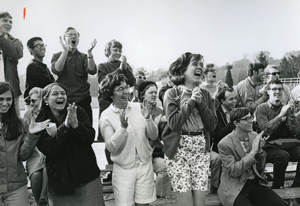 One lament today is that “The Age of Giants” has ended, because of a reputed switch in admissions policy which favors “the well-rounded kind” rather than individualists. A group of juniors agreed. “Our class hasn’t developed any particular characteristics. We don’t have any big men.”
One lament today is that “The Age of Giants” has ended, because of a reputed switch in admissions policy which favors “the well-rounded kind” rather than individualists. A group of juniors agreed. “Our class hasn’t developed any particular characteristics. We don’t have any big men.”
The Pottery Bug
The Giants’ influence continues, though, in the large number of students who use Swarthmore’s recently opened Arts Center, which includes an experimental theater, an art gallery, music practice rooms, and an art studio featuring four potters’ wheels. Students are quick to mention the latter, perhaps because of their novelty. “Before Christmas, you get about 70 people in here making presents. There are 10 or 15 of us who use them regularly,” said one, who had worked as a potter’s apprentice the year before as a result of his Swarthmore experience. “One girl even quit school and became professional. After college, I’d like to get a wheel, settle down by the shore, and be a potter. But my parents want me to be a lawyer.”
This surge of creativity does not infect the whole campus—fraternity men and engineers are said to be less concerned than others—but it is still widespread. “When people want to let off steam, they’re likely to do it by painting a picture,” said Dean of Admissions Fred Hargadon.
Dean of Women Barbara Lange ’31 estimated that “interest in creative arts is higher here than at most other schools. It’s so intense—we have a hard time satisfying it.” A continuing debate centers on the question of whether courses in the applied arts should be given for credit, and the answer up to now has been a firm “no.” Swarthmore has always felt that courses in technique, either in art, writing, music, or dramatics, are not properly part of liberal arts education.
The student who is deeply committed to his creative work must either comply with Swarthmore’s demands and work out some kind of personal compromise or leave school. President Courtney Smith has said, “A man will be a better flute player for having studied history and philosophy.” But this is sometimes scant consolation for the truly creative student.
Having made this initial decision, though, the school does all it can for student artists, writers, musicians, and actors, recognizing that their presence is part of what makes Swarthmore so lively. Faculty members are trying to lessen the course loads in the freshmen and sophomore years—in response to the complaint that the workload leaves little time for creative work—and they are often willing to read student writing or help the LTC.
Noncredit Courses
The school pays teachers of arts and crafts to give noncredit lessons in drawing, painting, and pottery; it also sponsors music groups. Perhaps the arts are lively at Swarthmore precisely because students have to make time for them on their own. Dean Lange was concerned, though, because, “We don’t have the facilities or the time to give to creative writers.”
Despite this, 19 student-written one-act plays were submitted in this year’s contest; three will be staged in the spring.
One of editor Scheinman’s pet ideas concerns the possibility of a separate arts school on campus so that artists wouldn’t need to keep up with Swarthmore’s rigorous academic standards but could still benefit from being part of the academic community. The regular student body in turn would benefit from the artists.
Honors Students Take Only Two Seminars Each Semester
For many students, the most rewarding satisfactions at Swarthmore are academic. The famous Honors Program, more than 40 years old, is still revolutionary. An outline of its details can only begin to account for its influence on the student body.
The Honors Program starts junior year. Instead of the course program of four courses a semester, Honors students take two seminars instead. The eight seminars spread across four semesters are supposed to make up a coherent program, with four seminars in the student's major, and two in each of two related minors.
Small Seminars
Seminars, which never have more than seven students, meet for three to five hours once a week. Some seminars meet in professors’ houses—as many faculty members live on or near campus—but even if they don’t, the professor’s wife is supposed to provide refreshments for a mid-afternoon or mid-evening break.
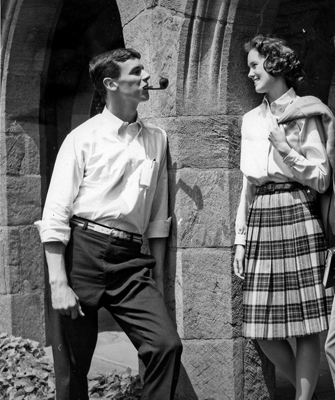 These breaks are obviously conducive to casual and close friendships between professors and students. This tendency is encouraged by the fact that these professors are not testing or grading their honors students; that will be done later, in the spring of senior year, by outside examiners from other colleges and universities. There is a sense, therefore, in which students and faculty are allied against the outside graders.
These breaks are obviously conducive to casual and close friendships between professors and students. This tendency is encouraged by the fact that these professors are not testing or grading their honors students; that will be done later, in the spring of senior year, by outside examiners from other colleges and universities. There is a sense, therefore, in which students and faculty are allied against the outside graders.
Despite the fact that some departments are much more selective in admission to the Honors Program than others, honors students are universally respected. President Smith feels this program is the reason most of Swarthmore’s students are attracted in the first place, even if many later decide that it doesn’t suit their tastes or temperament. About 40 percent of a class takes honors.
Two Teaching Methods
In spite of the prestige of the Honors Program, deans and professors emphasized that the honors and course programs are just two different teaching methods going on side-by-side. They readily admitted, though, that one of Swarthmore’s real problems is keeping the course program vital and active.
Every department has to maintain an Honors Program, but some have quite weak offerings. Some courses listed in the catalogue haven’t been offered for years. In physics, for example, “You have to honor, or you’ll get shuffled off into engineering courses,” one boy said.
Professors’ Interests
It is natural to expect that professors will be more interested in their seminars than in their courses, especially since they are often teaching a course and a seminar on the same topic simultaneously. Not only are the seminar students spending twice as much of their academic time on the subject (one-half instead of one-quarter), but they are also more likely to be future professionals in the field. Many fine students do not go into the Honors Program. But while the Honors Program runs on its own momentum, the course program needs, and is getting, more conscious attention. Some professors, for example, are experimenting with breaking up their courses into honors-style seminars. Others put extra work into preparing their course lectures.
However, these tendencies are fighting against a feeling that, as one professor said, “the course program is for students who on the whole prefer a more passive role in their education; they'd rather just sit and listen to lectures.”
‘Passive’ Courses
Any efforts in the direction of mixed programs of courses and seminars runs into one of Swarthmore's most strongly held convictions—that the Honors Program is a different teaching method and cannot be combined with traditional courses. One faculty member, admitting that he was a “purist” about the Honors Program, said that the independent, individual, uncertain experience of preparing for weekly seminars could only be injured by students having to prepare daily assignments for more structured courses at the same time.
Students in a seminar often get together on their own to work out problems or just to talk about their work. In one physics seminar, part of the week’s assignment was to “read through the electrostatics chapters of other texts looking for insights that our text misses.” There were also specific reports for the next week.
A thesis is not tied to the Honors Program. An opportunity exists in some departments to substitute a thesis project for one seminar in senior year, but it is seldom taken, perhaps because enough independent work is done in the seminars themselves.
‘Joylessness’
Students spend hours a day—eight to 10 are not unusual—completing their assignments. Still, professors complain sometimes that they do nothing more than is required.
“We wish they’d skip an assignment they’re bored with if there was a project they were more interested in,” says one. A biology professor identified a “joylessness” in Swarthmore studies, wondering whether this was due to lack of enthusiasm among faculty or among students. He described a “tenseness, due to seeing how hard everyone else is working.”
The Honors Program is least successful in the natural sciences, where the nature of the material to be covered often doesn’t lend itself to presentation in small seminars. “It’s much easier to give lectures on a complicated subject than to put it across in a seminar form,” said one scientist.
One striking aspect of the Honors Program, considering Swarthmore’s position as a “liberal arts” college, is its seeming specialization. The freshman and sophomore years include distribution requirements, but most honors students can’t dabble in courses that happen to strike their fancy after sophomore year. While honors students take half of their seminars outside of their major field, their two minors must make up a coherent program. They cannot, for example, major in English and minor in economics and political science. Nor can they take a single seminar in any department; each minor must include two seminars.
Studying for Comps
The rationale behind this policy is that this kind of discipline is in itself a “liberalizing” experience. As honors students prepare for written and oral exams in all eight seminars late in senior year, they are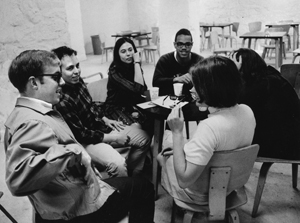 supposed to encounter a moment when all the separate areas and the three disciplines they have been studying fit together, suddenly and meaningfully. This is the “liberalizing” effect of liberal arts education at its best, the college believes. “The only trouble is,” said one skeptical honors candidate, “that if you don’t piece it all together, you fall apart.” (He added that after Swarthmore comps and orals, “the Ph.D. comps are supposed to be nothing.”)
supposed to encounter a moment when all the separate areas and the three disciplines they have been studying fit together, suddenly and meaningfully. This is the “liberalizing” effect of liberal arts education at its best, the college believes. “The only trouble is,” said one skeptical honors candidate, “that if you don’t piece it all together, you fall apart.” (He added that after Swarthmore comps and orals, “the Ph.D. comps are supposed to be nothing.”)
Two other comments on academic preparation. The curriculum is quite traditional; while students can work out a wide variety of coherent programs, there is nothing comparable to Amherst’s interdisciplinary American studies venture. Swarthmore has also been slow to add new departments like sociology and anthropology.
Second, 70 to 80 percent of Swarthmore graduates go on to graduate school—an amazing figure for a coeducational school. The deans call it a cause for concern, and one student, asked about his future plans, joked, “Maybe I’ll join the Army to get out of grad school!”
Faculty-Student Relations is ‘This Year’s Issue’
Leftists and Goldwaterites
Politically, Swarthmore students are more moderate nowadays than previously. One explained, “Swarthmore used to be politically between the mid left and far left, with the middle of the road being to the left of Kennedy. There were at least 100 socialists, and for years a small group of radical artists, as well as scattered anarchists. It’s much tamer now. Our leftists have the Students for a Democratic Society mentality now, and the admissions office has even brought in 20 Goldwater people!”
The Goldwater supporters on campus last fall were mostly freshmen and weren’t taken too seriously by the students we talked to. A Tennessee freshman complained of the limits of Swarthmore tolerance. “They’re tolerant of everyone except conservatives.”
The campus abounds with SDS literature, and a dining hall petition urging that the United States get out of Vietnam had collected about 90 signatures.
Swarthmore was founded by the Society of Friends, and although the school has only a small percentage of Quaker students, the value that Quakers have attached to constructive work on society’s problems permeates the campus. Many students not only spend spare weekends and vacations in work-camp projects, tutorials, and other civil-rights and social-work activities, they also keep engaged in these projects during school. Swarthmore students were at the head of the Chester civil-rights demonstrations of the last couple of years, for example.
‘Should Have Been Shot’
But Chester and its problems are now largely out of student hands, and if students are wistful in recalling the days when you could feel you were really doing something (even if that meant getting beaten or arrested), the administration seems just as glad those days are over. The school received bad public relations in the Chester days. When the papers ran a picture of a Swarthmore student who had been beaten, talk-radio listeners contended he had gotten off easy: “He should have been shot.”
Ad Hoc Committees
Even without the impetus of a Chester, students seem to spend their time in almost compulsive organizing. Nobody petitions the administration to do a certain thing; instead they form a committee to investigate doing it. One sign on a bulletin board was typical:
“We the undersigned, students with an active interest in the propagation and extension of the above-mentioned propagations and extensions hereby announce our intentions
for the invention
of an ad hoc committee
to put two pinball machines in Somerville
to reduce tension”
Amid the alphabet soup of the numerous committees, one classic stands out. The Phoenix reported that a recently established subcommittee of the ad hoc interim snack bar committee will “draw up immediately as detailed a report as possible.”
Student complaints are relatively minor. One common worry these days (denied by the deans) is that classes are getting larger, for Swarthmore is on the way from 1,000 to 1,200 students.
Faculty and Students
“Faculty-student relations is this year’s issue,” says Dean Lange. She admitted that a student coming to Swarthmore expecting idyllic student-faculty relations could find the freshman year “disappointing.” One student spoke for many when he said, “I realize that the faculty would be quite approachable, if I bothered to take the initiative. I just don’t have the time.”
A committee on student-faculty desserts has been set up. This committee administers a fund through which students can go to faculty homes for dessert at the College’s expense. Students are also urged by the administration to invite faculty members and their families to Sharples for a meal. Although teachers do entertain students, they don’t go out of their way.
They worry enough about their students’ mental health, though, to have put on the musical The Boy Friend during exam week to relieve the tension. A program of movie cartoons also brightened the grim atmosphere.
About 42 percent of Swarthmore men join one of five fraternities. They all used to be national, but three have gone local over the racial-discrimination issue. At present, they are all integrated in theory and in practice.
Though all students live in dorms, fraternities do have attractive lodges on campus for parties, meetings, and games like pool and ping-pong. Fraternity parties are generally open only to members and their dates, except when rushing is on in the fall.
In the words of one dean, fraternities supply “more organized group activities. Boys who want a more traditional social program and athletics are likely to join.” The fraternities differ in their drinking, social, academic, and athletic habits. In one house a boy turned in a couple of his brothers for breaking the liquor rules.
Easy Mixing
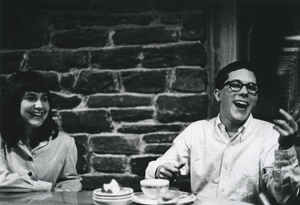
Fraternity and nonfraternity groups seem to mix easily; neither group despises the other for being “bohemian” or “philistine.” “The fraternities will take anybody,” as one nonfraternity boy said. “The old daysare over.” In the dining hall, for example, no one clique has staked out an area as they do at Amherst, though fraternity groups are sometimes seen together. “There’s a group of DU animals,” one girl pointed out, “but of course Swarthmore animals are nothing.”
Two of Swarthmore’s persistent issues are liquor and sex. The campus is officially dry. “Open houses” (women visitors in men’s dormitory rooms and vice versa) were recently extended to one afternoon and one evening (Saturday) a week. They are run on an “open door” policy (45 degrees), with proctors to check.
Although student attitudes toward these policies vary, there is discreet but widespread flouting of the rules. Parties in dormitory rooms are undiscovered as long as noise is kept low, and boys who have dates in their rooms on an illegal evening check before they answer a knock at the door. One wag in Mary Lyon, the most liberal of the men’s dorms, said that “if you had a fire drill there in the middle of the night, more girls would come out than boys.” Since girls’ dorms have no one on watch, girls who plan to stay out all night just don’t sign out.
Campus Center
The dining hall, as much as any other place, catches the spirit of Swarthmore student life, serving as a combination information desk, Washington Square, and Hyde Park. It is where bulletins about weekend work camps go up, where a hootenanny starts after dinner on Saturday, or where student orators in the upper lobby harangue the crowd below, as happened before last November’s election. It is where, as one girl described, “If someone says something interesting, a whole crowd will gather around to join the discussion.
“There’s no such word as ‘apathy’ here,” she continued. “Right now I’m madly in love with the place, and a few weeks ago I hated it. It’s always one or the other. Everyone feels that way.”
SAGA of the Dining Hall
Pyramid-shaped Sharples Dining Hall, which opened last September, is where all Swarthmore students eat. Its high, impressive fieldstone interior includes an upstairs lobby, coat rooms, lounges, and three lower-level dining areas that spread out around the central court, dominated by a fireplace. Students can go through one of the back-to-back cafeteria lines or sit down to be served in a smaller, red-carpeted dining room.
As striking as the building, however, is the food, supplied by SAGA, a national college-food plan. For $530 board per year, students can get all they want of everything (including juices and desserts) except, of course, the Saturday-night steak.
There is a choice of main courses three meals a day, and a typical breakfast includes eggs and pancakes or French toast, doughnuts, cereal, toast, and several kinds of fruit and juice. There is a wide choice of salads, salad dressings, desserts, and beverages every lunch and dinner. And if you still aren’t satisfied, there’s always peanut butter and jelly on the relish table! Best of all, perhaps, is that the dinner rolls—an indescribable delight—are hot!
Collection
Swarthmore students love to complain about Collection, a one-hour lecture each Thursday morning, from which only four cuts a semester are allowed. The speakers are too often minor governmental officials (“The College can get them cheaply,” explained one student), but are sometimes alumni, faculty, or special guests like Margaret Mead, this last week’s speaker.
Many students feel that something should be done about Collection. In addition to formal protests, student committees study alternatives, but students have more insidious ways of fighting the existing situation.
The most famous prank involved letting bags of marbles loose in the back row. The resulting thunder as the marbles rolled down the auditorium floor to the front effectively broke up that Collection.
A more common weapon is also more passive—The New York Times. “You can judge a speaker by how far he gets before people start bringing out their Times-es,” says one, “and a really bad one will draw several hundred.” Alumni sometimes start their speeches by nervously joking about the practice, “I wonder how long I have before the papers come out? …” which is always the signal for a wall of Times-es to appear.
The Student Council
The Student Council at Swarthmore is elected at-large each semester, with no attempt at representation by class, fraternity, or living unit (There are no freshman dorms at Swarthmore).
Some of the council’s actions have been quite successful; they once paid for University of Pennsylvania professors to come to campus and give noncredit lectures in sociology. This was to show the administration that there was real interest in the subject, and as a result the school is taking steps to start its own department.
The council does serve as an avid collector and refiner of student gripes. Any and all gripes are solicited, for any gripe could serve as the justification for a new committee.
A recent survey is typical; there were questions covering every conceivable gripe, and more subtle questions as well. Samples:
“Are you bored with your dining hall number?”
“Do you think there should be a magazine of political satire on campus?”
“If yes, why haven't you started one?”
“Does President Smith remind you of your father?”
-published in the Amherst Student, Feb. 18, 1965
 Email This Page
Email This Page